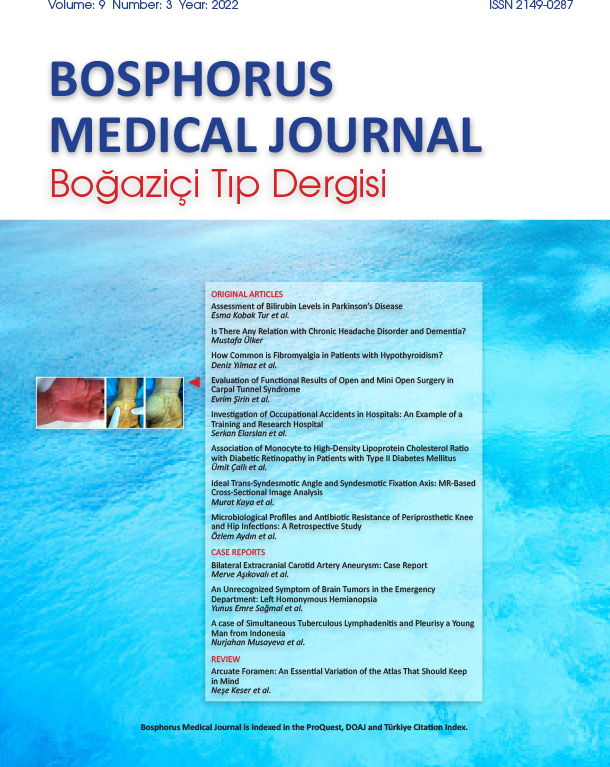High Levels of HbA1C among Internal Medicine Inpatients and Relationship with Undiagnosed Diabetes Rates
Elif Yıldırım Ayaz1, Nalan Okuroğlu2, Ali Özdemir21Department of Internal Medicine, Sultan Abdülhamit Han Training and Research Hospital, İstanbul, Turkey2Department of Internal Medicine, Fatih Sultan Mehmet Training and Research Hospital, İstanbul, Turkey
INTRODUCTION: Diabetes Mellitus (DM) is a significant cause of mortality and morbidity and may lead to microvascular and macrovascular complications. This can be prevented through early diagnosis of diabetes and achieving glycemic control. Measurement of the fasting glucose, random glucose, oral glucose tolerance test (OGTT) and HbA1C levels have been adopted in the diagnosis of diabetes. This study has searched for DM diagnosis rate using HbA1C measurements in the inpatient population.
METHODS: This retrospective study included all inpatients whose HbA1C levels were measured at the Internal Diseases Clinic of Fatih Sultan Mehmet Training and Research Hospital in 2015. Glucose, blood urea nitrogen (BUN), creatinine, fasting glucose levels, age, gender and primary causes of admission of the patients were recorded. The patients, who had HbA1C value of 6.5 or more, were defined as newly diagnosed DM. Before this study, the patients were included in three groups as patients with a previous diabetes diagnosis, patients with a new diabetes diagnosis and patients with no diabetes diagnosis.
RESULTS: Among 1057 patients included in this study, 29.7% had past diabetes diagnosis (Group 1), 7.5% were newly diagnosed diabetes, while 62.8% patients have no diabetes. No statistically significant difference was found concerning age and gender distribution. No significant difference was found between the HbA1C, fasting glucose and random glucose levels of Group 1 and Group 2. BUN levels of the patients in Group 3 were lower than those in Group 1. Creatinine levels of Group 1 were higher than in Group 3. No significant difference was identified concerning the duration of hospital stay and mortality between the groups.
DISCUSSION AND CONCLUSION: New DM diagnosis rate was 7.5% among the patients admitted to the internal diseases clinic within a year. Besides, in the high-risk population of inpatients, the routine HbA1C measurement may lead to early diagnosis by increasing the undiagnosed patient rate.
Dahiliye Kliniğinde Yatan Hastalarda HbA1C Yüksekliği ve Daha Önce Tanı Konulmamış Diyabet Oranı İlişkisi
Elif Yıldırım Ayaz1, Nalan Okuroğlu2, Ali Özdemir21Sultan Abdülhamit Han Eğitim ve Araştırma Hastenesi, İç Hastalıkları Departmanı, İstanbul2Fatih Sultan Mehmet Eğitim ve Araştırma Hastanesi, İç Hastalıkları departmanı, İstanbul
GİRİŞ ve AMAÇ: Diyabetes Mellitus mikrovasküler ve makrovasküler komplikasyonlara sebep olarak önemli bir mortalite ve morbidite sebebi oluşturur. Diyabette erken tanı konulması ve glisemik kontrolün sağlanması ile bu önlenebilir. Diyabet tanısı konmasında açlık glukoz, random glukoz, OGTT ve HbA1C düzeyleri ölçümü benimsenmiştir. Bu ça- lışmada yatan hasta popülasyonunda HbA1C bakılması ile yeni tanı DM saptama oranına bakılmıştır.
YÖNTEM ve GEREÇLER: Bu retrospektif çalışmaya 2015 yılında Fatih Sultan Mehmet Eğitim ve Araştırma Hastanesi İç Hastalıkları Kliniğinde yatan, HbA1C düzeyine bakılmış olan tüm hastalar dahil edilmiştir. Hastaların random glukoz, BUN, kreatinin ve açlık glukoz değerleri, yaş, cinsiyet, primer yatış nedenleri kaydedilmiştir. HbA1C 6.5 ve üstü olması durumunda yeni diyabet tanısı konulmuştur. Hastalar daha önce diyabet tanısı olan, yeni diyabet tanısı alan ve diyabeti olmayan olarak üç gruba ayrılmıştır.
BULGULAR: Bin elli yedi hastanın %29.7sinde daha önce diyabet tanısı mevcuttur (Grup 1), %7.5'ine yatışı sırasında yeni tanı konmuştur, %62.8inde diyabet yoktur. Gruplar arasında yaş ve cinsiyet açısından farklılık bulunmamıştır. HbA1C, açlık glukoz ve random glukoz düzeylerinde Grup 1 ve Grup 2 arasında anlamlı farklılık bulunmamıştır. Grup 3teki hastaların BUN değerleri Grup 1deki hastalardan düşüktür. Grup 1in kreatinin değerleri Grup 3ten yüksek bulunmuştur. Gruplar arasında yatış süreleri ve mortalite açısından anlamlı farklılık saptanmamıştır.
TARTIŞMA ve SONUÇ: Bir yıl içerisinde dahiliye kliniğinde yatan hastalarda yeni tanı DM saptama oranı %7.5 bulunmuştur. Yüksek riskli popülasyonlarda, yatan hastalarda HbA1Cnin rutin ölçülmesi daha önce tanı almamış hastaları belirleyerek diyabetin erken tanınmasını sağlayabilir.
Manuscript Language: English




















